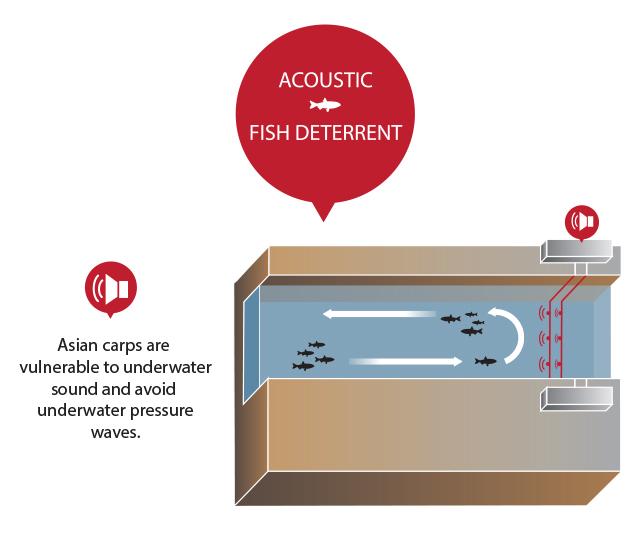Acoustic Fish Deterrents use sound/pressure waves (noise) to influence behaviour or injure aquatic organisms. With regards to fishes, those most vulnerable to underwater sound are species with swim bladders. Carp fall into this category and thus should be sensitive to underwater sound at the resonant frequency of the swim bladder. The use of underwater ensonification could be effective in controlling carp movement within restricted waterways, where the sound cannot be avoided. If an Asian carp’s swim bladder is susceptible to specific frequencies, this approach may have the advantage of specifically targeting carps while not affecting other species.

There are two main types of acoustic deterrents:
Continuous Wave
- Uses high intensity, low-frequency sonar waves generated from a Low Frequency Active (LFA) sonar source array
- This array is comprised of a set of acoustic transmitters that produce sound which is irritating to fish
- Originally developed by the United States Navy to identify submarines (Tyler 1992)
- Now being tested to determine if it can be used as a deterrent or as part of a fish guidance system or barrier
Pulsed Wave
- Pulsed pressure waves are high intensity sound/pressure waves generated by a sound source (hydro gun, air gun, blast explosive)
- Irritate, harm, or kill aquatic organisms
- Hydro guns produce sound waves using a pneumatically or hydraulically powered piston
- Very low operating pressures at a sub-lethal level may motivate fish to move from the direction of the source
General Effectiveness
The response of fishes to loud noises ranges from:
- No response
- Short term avoidance (moving away from the sound source)
- Long term avoidance (altering behaviour to avoid the sound)
- Physiological damage (hearing loss)
- Death (tissue disruption)
A variety of factors including frequency of pressure waves, intensity, duration, and distance from acoustic source influences effectiveness.
Operating Constraints
The repeated use of these technologies…
- May have a damaging effect on canal walls and underwater structures
- Would impact navigation
- May present safety issues, possibly requiring public access restrictions
- Both controls may require the armoring and shoring of canal walls and underwater structures to withstand repeated shock waves.